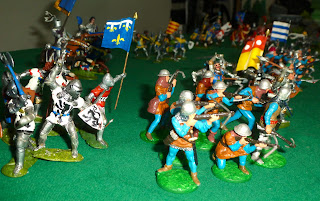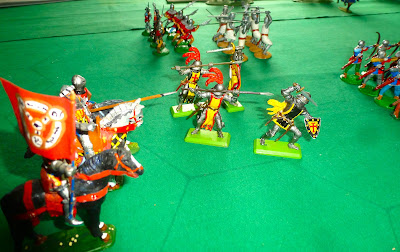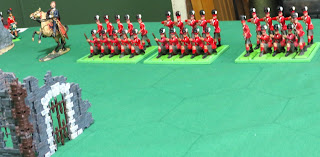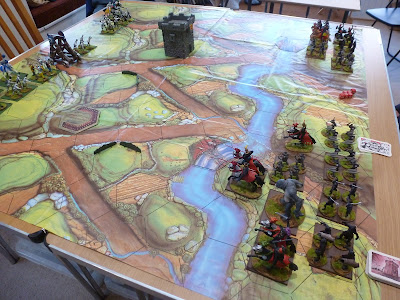Travel Battle is a boardgame designed by Michael Perry and produced by Perry Miniatures, the well known wargame figure manufacturers, it's based on battles in the Napoleonic period so Anthony and I thought we'd see how well the system translated to a tabletop wargame with 54mm toy soldiers. Here's how it went:
As usual we started with a very simple game, without may terrain features, to test out the mechanisms of the system. The boardgame has preformed terrain and uses a square grid for movement, we opted to use a hex grid (because that's all I've got and I prefer it!)
Each side comprises 3 Brigades, each commanded by a mounted Brigadier and made up from any combination of the units available, which are; 2 x Heavy Cav. 2 x Light Cav. 2 x Artillery. 2 x Guard Inf and 6 x Line inf. Either or both of the Artillery units may be attached to a Cavalry Brigade and designated as Horse Artillery, which has greater movement distance but less firing range and effect than the Foot Artillery.
The rules are simple, minimal and there is no record keeping, just how we like them but may be a bit too simplistic for some. Players dice to see who goes first and can activate all their units, the sequence of play is: Move, Fire Artillery, Melee, Retreat any defeated units. Then the second player repeats the sequence with their units.
Foot units (Guards, Line inf. and Foot Artillery) move 1 hex while mounted (Brigadier, Horse Artillery, Heavy and Light Cav.) move 2 hex in each turn. All units can move in any direction and terrain modifiers apply.
Firing is restricted to the Artillery who can move or fire but not both. Effect is determined by D6 score: 1,2,3 no effect, 4 target falls back 1 hex, 5 target retreats back to table edge or 6 target destroyed.
Combat occurs when opposing units move into touch, in such case Artillery cannot fire but fight as an infantry unit. Combat is decided by dice throw, with Heavy Cav. and Guard Inf getting a bonus. Both players dice, highest score wins and outcome is determined by score differential: 1 losing unit falls back 1 hex, 2 unit retreats back to table edge or 3 unit destroyed.
Command and Control is an interesting feature of the system, every unit in a Brigade (including the Brigadier) must be touching at least one other unit from the same Brigade, any that are not in touch with the Brigadier through the line of units cannot move but can fight if attacked (and Artillery can still fire). So if a unit in the centre of a line is destroyed the line is broken and units beyond the break are no longer under command. There are modifiers for the effects of moving into square to protect infantry against cavalry but make them devastatingly vulnerable to artillery fire.
The figures we used were mostly Britains Deetail with a few DSG toys soldiers from Argentina. The Brigadiers on both sides are Del Prado Napoleonic personalities, beautifully modelled and their larger size giving a commanding presence on the table top.
Overall I found it very easy to pick up and the action moves fluidly, the system would work very well for large battles and we could easily have controlled twice the number of units or Brigades, it would be ideal for multi player games. With little modification it would also translate well to cover European battles of the Seven Years War.
I particularly liked the Brigade structure and control system but not so much the Combat where the outcomes are either fall back, rout or be destroyed, there are no casualties depleting unit as you get in say Lionheart or One Hour Wargames, so it's good but it ain't no game of toy soldiers!


















































.JPG)
.JPG)
